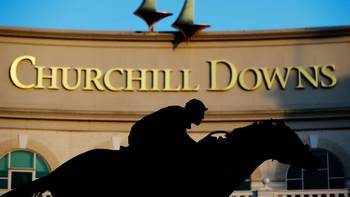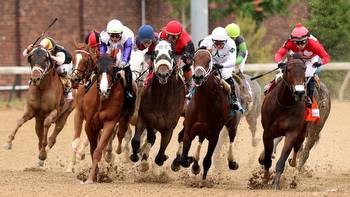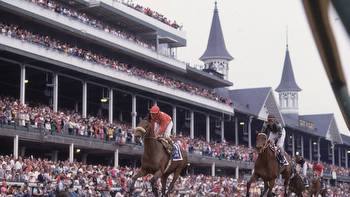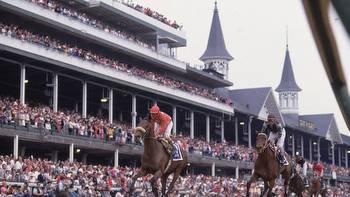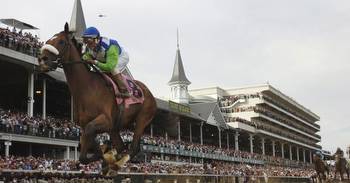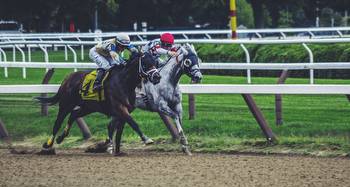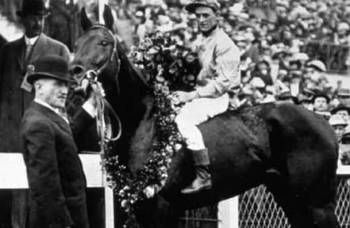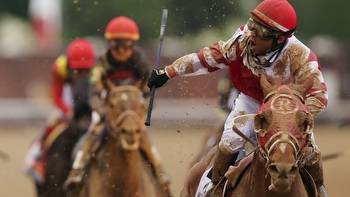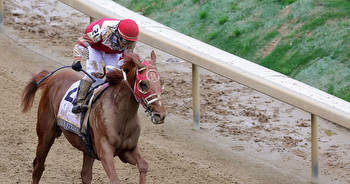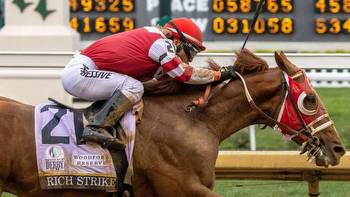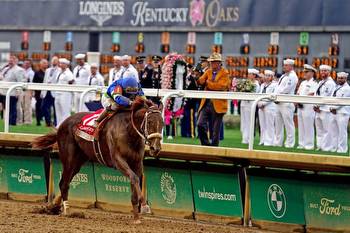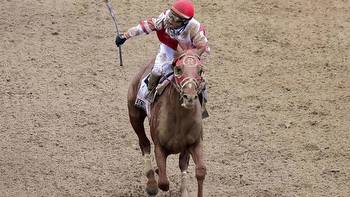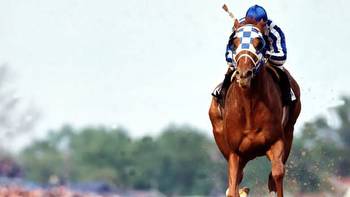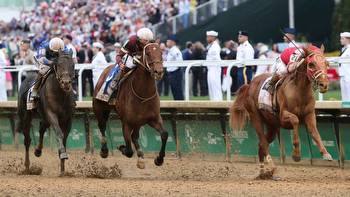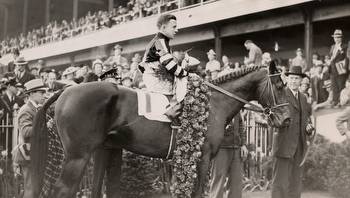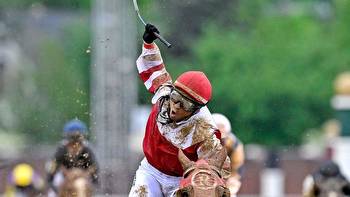Previous Kentucky Derby long shots like Rich Strike have struggled to win again
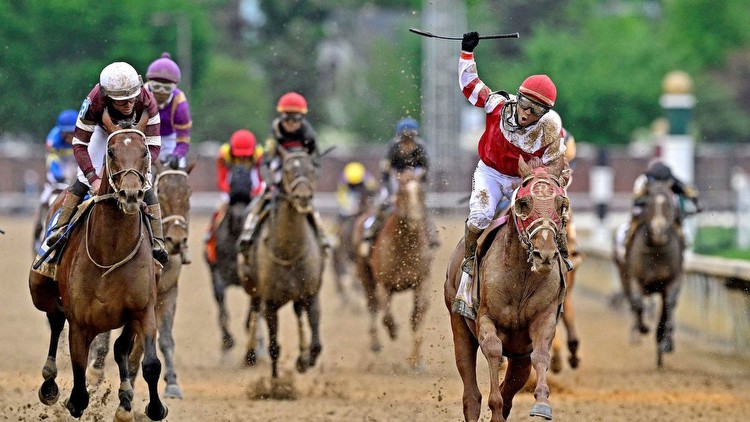
Rich Strike shocked the horse racing world Saturday by winning the Kentucky Derby at 80-1 odds. The colt was such a late entry to the race that he was not even included on souvenir T-shirts sold at Churchill Downs:
Rich Strike was the second-biggest long shot to win the race but now has a chance to win the Triple Crown (assuming he runs in the Preakness Stakes on May 21).
It remains to be seen what Rich Strike’s future will look like, but nearly all of the other Kentucky Derby long-shot winners found it difficult to replicate that unlikely success. Here’s a look at what the 10 most unlikely Kentucky Derby winners did after winning the Run for the Roses.
Donerail (91-1, 1913)
The Kentucky-bred bay colt won four races as a 2-year-old but none as a 3-year-old, and trainer Thomas P. Hayes didn’t want to enter him in the Kentucky Derby until a friend offered to pay the entry fee. Worse still for his chances, Donerail was stabled about three miles from Churchill Downs — which had no more room — at Douglas Park and had to walk over cobblestone and dirt roads on the morning of the race. But he sped past the favorites to win by a half-length in 2 minutes 4⅘ seconds, the fastest time at that point.
Donerail didn’t run in the Preakness or the Belmont — the term “Triple Crown” had not yet come into widespread use — but won the 1913 Canadian Sportsman’s Handicap and either won or hit the board in a number of races the next year before an injury robbed him of his form, though he did continue racing through his 8-year-old season.
Rich Strike (80-1, 2022)
Trainer Eric Reed said Sunday that he and owner Rick Dawson would like to observe the colt over the next few days before committing to the Preakness.
Country House (65-1, 2019)
Country House crossed the finish line in second place at the 2019 Kentucky Derby but was declared the winner after race stewards disqualified first-place Maximum Security for coming out of his lane and bumping another horse.
A virus kept Country House out of the Preakness; it was the first time since 1996 that the Kentucky Derby winner did not race two weeks later at Pimlico. Other health issues then forced Country House into retirement. He now stands stud at Darby Dan Farm in Kentucky.
Mine That Bird (50-1, 2009)
The Canadian-based colt came from well back of the pack to win the 2009 Kentucky Derby by 6 3⁄4 lengths, the fifth-largest margin in the race’s history. The original plan was for Mine That Bird to skip the Preakness and point toward the Belmont Stakes — just like his sire, Birdstone, the 2004 Belmont winner. But his handlers decided to take their shot at the second leg of the Triple Crown, even though jockey Calvin Borel would be aboard dominant Kentucky Oaks winner Rachel Alexandra in Baltimore. With Mike Smith aboard, Mine That Bird nearly replicated his Kentucky Derby run but failed to catch favorite Rachel Alexandra and lost by a length.
With Borel again aboard, Mine That Bird finished third at the Belmont Stakes after briefly holding the lead at the top of the stretch. Later that year, he finished ninth at the Breeders’ Cup Classic.
In 2014, Mine That Bird’s story was told in the Hollywood film “50 to 1,” which garnered mainly negative reviews.
Giacomo (50-1, 2005)
The gray stallion didn’t get a lot of credit for winning one of the slower Kentucky Derbies in modern history, and his Beyer Speed Figure of 100 was the worst in at least 20 years. He then finished third in the Preakness and seventh in the Belmont Stakes, with Afleet Alex winning both races after finishing third at the Derby.
Giacomo would win only one more stakes race (the 2006 San Diego Handicap at Del Mar), and he finished fourth in that year’s Breeders’ Cup Classic before being retired to stud.
Gallahadion (35-1, 1940)
The Kentucky Derby was more or less the lone moment of glory for Gallahadion, who beat heavy favorite Bimelech in 1940. According to American Classic Pedigrees, the win came about more because of Bimelech’s “rushed and poorly thought out preparation for the Kentucky Derby.”
Gallahadion finished third at the Preakness and a distant fifth at the Belmont, with Bimelech winning both races, and his struggles continued in 1941. His stud career also was underwhelming: He sired 73 winners, none of them stakes winners.
Apollo (32-1, 1882)
The most ancient long shot on this list, Apollo won the eighth running of the Kentucky Derby. (It was a 1½-mile race back then as compared with 1¼ miles now.) Until Justify in 2018, Apollo was the only Derby winner who didn’t race as a 2-year-old.
In the Derby, Apollo clipped Runnymede by a half-length at the finish line. The horses would race again only six days later at the Clark Stakes, with Apollo finishing third and Runnymede winning.
Apollo would go on to win 10 races in 21 starts as a 3-year-old and won 14 more times as a 4-year-old — at one point he won seven straight races — before suffering a career-ending injury as a 5-year-old.
Charismatic (31-1, 1999)
Charismatic is the only horse on this list to win the Kentucky Derby as a long shot, then also win the Preakness Stakes. He wasn’t the favorite in that race, either, with 8-1 odds compared with favorite Menifee at 5-2. Menifee finished second to Charismatic in both races.
Charismatic was the 2-1 favorite at the Belmont Stakes and led early in the race, but his hopes of the first Triple Crown since 1978 were dashed by a fractured foreleg suffered later in the race. (He still finished third in what would be his last appearance on a racetrack.) Charismatic would go on to a highly successful stud career, siring 371 starters who brought in more than $44.5 million in career earnings.
Proud Clarion (30-1, 1967)
After a thoroughly unspectacular 2-year-old career but a second-place finish in the 1967 Blue Grass Stakes, few expected much from Proud Clarion at that year’s Kentucky Derby. But he came from well back to beat Barbs Delight by a length in what was then the third-fastest time in the race’s history.
Proud Clarion would go on to finish third in the Preakness Stakes and fourth in the Belmont Stakes, with Derby favorite Damascus winning both races. He would win six more times as a 3-year-old, with one stakes victory, but finished no better than second in nine races as a 4-year-old. Proud Clarion then was retired to stud, siring at least 30 stakes winners.
Exterminator (29-1, 1918)
So little was thought of Exterminator that his owner called him “that truck horse” or “the goat” (not the Tom Brady kind). The 1918 Kentucky Derby was the colt’s first race since his 2-year-old season, and his long-shot odds reflected that. But on a sloppy track, Exterminator caught the leaders on the final turn and won by a length.
Exterminator won seven of his next 14 races as a 3-year-old and had a highly successful career, earning horse of the year honors in 1922. He was inducted to the National Museum of Racing and Hall of Fame in 1957 and ranked 29th in BloodHorse’s 1999 rankings of the top 100 thoroughbred champions of the 20th century.
What to know about horse racing
A beginner’s guide to betting on horse racing: Horse racing can be intimidating to newcomers. This guide will help you navigate the lingo, assist you in evaluating horses and give you the proper tools to enjoy a day at the races.
How to pick the winner of a horse race: It’s not enough to know which horse is the fastest or has the best connections. Here is how to break down a field.
The dark side of Bob Baffert’s reign: As horse deaths and drug violations mounted, thoroughbred racing’s top trainer used power and money to keep beating opponents — and regulators.
Investigation: A years-long effort by the sport’s moneyed elite exposed the underbelly of the industry, paving the way for sweeping reforms. But critics see something different: a move by wealthy and politically connected horsemen to strengthen their hold on the industry.

